Queen Mary's Hospital
for the East End
for the East End
West Ham Lane, E15 4SD
Medical dates:
Medical character:
Accident. Later, general and maternity
The West Ham, Stratford and
South Essex Dispensary was opened in July 1861 by a local doctor, William
Elliot. It was located in an old house constructed from ships'
timbers at 30 Romford Road, lent by a Stratford resident, Mrs Mary Curtis.
These premises soon proved inadequate due to demand and Mrs Curtis donated a plot of land in West Ham Lane for a new dispensary. Mr Curtis donated £1000 towards the cost of the building.
The new Dispensary opened in 1879 with the motto "Ohne Zaegern und ohne Zagen" ("Without hesitation or fear"). The 2-storey building had cost £4,000 and contained a waiting hall which could seat 150 people. There was also a consulting room, an ophthalmic dark room and a dispensing room.
In 1886 a meeting was held and it was decided that a committee should be formed to raise funds for the building of a hospital next to the Dispensary. The new building was to be in 'Queen Anne' style and would front the new road (now Bryant Street) and, in 1888, the foundation stone was laid by the Duke of Cambridge.
The West Ham, Stratford and South Essex Hospital and Dispensary, with 32 beds, was officially opened by the Duke of Westminster in 1890. It had cost £7000, including the land and the furnishings. It was to be used mainly for the treatment of accident cases, which otherwise had to be taken to the London Hospital in Whitechapel. The building contained two main wards - the Westminster (named after the Duke of Westminster) and the Withers (named after Mr Joseph Withers, who had donated £500) - and two small wards (for children or for isolation), an operating room, a reception ward and administrative offices. The medical staff consisted of two resident doctors, three visiting physicians and three consulting surgeons. A Matron was in charge of four nurses and two probationers. The old Dispensary became the new Out-Patients Department.
In February 1894 the philanthropist John Passmore Edwards laid the foundation stone for a new wing, having donated £3000 towards its costs. (He had originally intended to found a cottage hospital in West Ham, as he had done in East Ham.) He opened the new wing in April 1895. and the first patients were admitted in October. The wing had 24 beds; the two main wards were named after Mr. J.R. Roberts, who owned a department store in Stratford and had borne the cost of furnishing the wards, and Eleanor Edwards, wife of Mr Passmore Edwards. There were also two smaller rooms for "exceptional cases" and 10 single rooms. The upper floor contained a general sitting room for the nurses. The new wing fronted Bryant Street and had cost £3750.
Following this expansion, the Hospital was renamed West Ham Hospital. It had 60 beds - Westminster and Roberts Wards, each for 12 male patients, Withers Ward for 13 females, Edwards Ward for 19 children and an isolation ward of 4 beds. An annexe for nursing accommodation was added to the 'East Wing' at the cost of £339.
By 1898 the floors in the main wards were in poor condition, but nothing could be done and they were covered with linoleum.
In 1902 its name changed again and it became the West Ham and East London General Hospital. An X-ray apparatus was installed, gifted by Mr H. Bowman, a member of the Hospital Committee. Four freehold houses - 1-7 Water Lane, Stratford - were given to the Hospital by Mr Joseph Gould as a Coronation gift. The Hospital's Extension Committee attempted to buy the High School for Girls, which was located adjacent to the Hospital.
In 1903 electric lighting was installed in the operating theatre. In 1905 the Hospital building was entirely renovated with the aid of the Daily News Unemployed Relief Fund and the West Ham Unemployed Relief Committee. In 1904 the £12,150 needed to buy the High School for Girls was raised (the final £1000 had been contributed by Mr J.R. Roberts), and the purchase was completed in 1905. In July 1907 the Duchess of Malrborough laid the foundation stone for yet another extension, which would cost £40,000.
In 1909 it was renamed the West Ham and Eastern General Hospital. In 1910 King Edward VII died. He had conditionally promised to open new wards, but they were brought into use without ceremony in January 1911.
In 1911 the Hospital received a legacy of £20,000 from a Mr Joseph Withers, and another of £3000 from Mr Rudolph Zunz on the condition that a ward be named after his late wife, Annie Zunz. (Thirty four hospitals benefitted from the endowment from Mr Zunz, and many still have Annie Zunz wards today). The two new wards were named 'Annie Zunz' and 'Consuelo Marlborough'. The Hospital had 100 beds.
In 1912, in its Jubilee year, a laundry was built on the site. Two additional small wards with 10 cots were added - the 'Blandford' and the 'Ivor Spencer Churchill'; the Hospital then had 110 beds.
In 1913 new X-ray apparatus was purchased and a house - 6 Bryant Street - was purchased for use by the night nurses (later 4 Bryant Street was also bought). In the same year negotiations began for the purchase of the adjacent St John's Vicarage for use as a Nurses' Home. The bid failed (but was later succesful).
During WW1 the Hospital offered 50 beds for Army use and thus became affiliated with the Royal Herbert Hospital in Woolwich. In September 1914 the first wounded servicemen arrived. The Sunday School Hall in the adjacent Conference Hall in Bryant Street was placed at the disposal of the Hospital for use as accommodation for wounded soldiers. It held 38 beds. In 1915 the nearby St John's Vicarage was finally acquired for extension purposes. Nos. 8, 10, 5-17 Bryant Street were also purchased as well as four houses in Plaistow Road (Nos. 43-39). As residental accommodation for nurses was in short supply, Nos. 31 and 32 Hamfrith Road were leased for two years at £75 per annum. In 1916 King George V and Queen Mary visited the Hospital, with Queen Mary becoming its Patron in 1916. In 1916 30 additional beds were provided for soldiers, giving a total of 80 in all. By 1917 the number had increased to 93.
The Hospital was granted a Royal charter in 1917 and changed it name to Queen Mary's Hospital for the East End. In the same year Mr Charles Lyle donated £10,000 towards the cost of a maternity wing in memory of his wife, Margaret Lyle (mother of the then Chairman of the Hospital, Mr C.E. Leo Lyle, who later became Lord Lyle of Westbourne and Vice-Patron of the Hospital). In September 1919 the old Vicarage was adapted for 16 maternity beds. Another house - 209 Romford Road - was purchased for use as nursing accommodation (it later became the Night Nurses' Home).
After the war the South West Ham Committee presented Theydon Towers to the Hospital for use as a children's convalescent home. It was officially opened by Princess Mary in 1921.
In 1922 the foundation stone of a Nurses' Home was laid by Mrs C.E. Leo Lyle. In 1923 the Margaret Lyle Maternity Wing was opened officially by the Countess of Pembroke and Montgomery, and the Nurses' Home by Prince Henry, Duke of Gloucester. The Hospital then had 160 beds. In the same year the foundation stone was laid by Alderman Will http://www.newhamstory.com/node/1141Thorne, JP, MP, for a new £40,000 Out-Patients Department, which would also be the War Memorial of the County Borough of West Ham. Built on what was the middle of Chant Square, the new Out-Patients block was opened by Prince Henry at 11.00 on 11th November, 1924. It was the largest war memorial of any kind in Great Britain, and the fourth largest Out-Patients' Department.
In 1925 the Directors of the Daily News donated wireless equipment to the Hospital, ensuring that every patient had bedside headphones. A Pathology Laboratory opened in 1927 in part of the Out-Patients building.
In 1927 the foundation stone was laid by the Lord Mayor of London, Alderman Sir Rowland Blades, for the Nicoll Wing, a memorial to the Hospital's physician, Dr P.J.S. Nicoll, who had died in 1926 and had done much in the way of fund-raising for the Hospital. The new wing, built on the site of the original Dispensary, was opened in 1928 by Queen Mary. The 4-storey block, built for £35,00, contained a children's ward (Nicoll Ward) and a Solarium (which later became the Department of Physicial Medicine) on the first and second floors, with administration offices on the ground floor and recreational accommodation on the first floor. In 1929 Mrs Stanley Baldwin, wife of the Prime Minister, opened the isolation block of the Maternity Wing.
In 1937 the foundation stone for the King George V operating theatres was laid by the Lord Mayor of London, Alderman Sir George Broadbridge, KCVO) and the building was officially opened by the Duke of Gloucester in 1938. The Hospital then had 219 beds.
During WW2 the Hospital was evacuated and become a casualty hospital for air-raid casualties and sick and wounded servicemen. It was the first London hospital to be bombed. In September 1940 the Westminster-Withers Wing, the oldest section of the Hospital, was destroyed by a direct hit. Two nurses and six patients were killed. Later in the same week, the older portion of the Margaret Lyle Maternity Wing, the kitchen and laundry were severely damaged. The total number of beds were reduced to 164, even after repairs.
In 1946 Hillingdon House in Harlow was leased on generous terms from a Mrs E.H. Swire for use as a post-operative surgical annexe, thus relieving the Hospital's bed shortage. In 1947, by the agreement of the West Ham Borough Council, four wards were taken over at Plaistow Hospital for use as a medical in-patients department.
In 1948 the Hospital joined the NHS, as part of the North East Metropolitan Regional Health Board, under the control of the West Ham Group Hospital Management Committee.
In 1954 the Hospital had 128 general and maternity beds, with a further 35 in its annexe in Hillingdon House.
In 1979 it had 106 beds.
Queen Mary's Hospital, the oldest voluntary hospital in West Ham, finally closed in 1983, when Newham General Hospital opened.
Present status (February 2008)
The buildings have all been demolished apart from the preserved entry archway in Bryant Street, leading into the new Chopwell Close. The Out-Patients Department, built as a war memorial to the dead of WW1, has also gone and the dedicatory tablet is presumably lost.
The site has been redeveloped into a housing estate.
These premises soon proved inadequate due to demand and Mrs Curtis donated a plot of land in West Ham Lane for a new dispensary. Mr Curtis donated £1000 towards the cost of the building.
The new Dispensary opened in 1879 with the motto "Ohne Zaegern und ohne Zagen" ("Without hesitation or fear"). The 2-storey building had cost £4,000 and contained a waiting hall which could seat 150 people. There was also a consulting room, an ophthalmic dark room and a dispensing room.
In 1886 a meeting was held and it was decided that a committee should be formed to raise funds for the building of a hospital next to the Dispensary. The new building was to be in 'Queen Anne' style and would front the new road (now Bryant Street) and, in 1888, the foundation stone was laid by the Duke of Cambridge.
The West Ham, Stratford and South Essex Hospital and Dispensary, with 32 beds, was officially opened by the Duke of Westminster in 1890. It had cost £7000, including the land and the furnishings. It was to be used mainly for the treatment of accident cases, which otherwise had to be taken to the London Hospital in Whitechapel. The building contained two main wards - the Westminster (named after the Duke of Westminster) and the Withers (named after Mr Joseph Withers, who had donated £500) - and two small wards (for children or for isolation), an operating room, a reception ward and administrative offices. The medical staff consisted of two resident doctors, three visiting physicians and three consulting surgeons. A Matron was in charge of four nurses and two probationers. The old Dispensary became the new Out-Patients Department.
In February 1894 the philanthropist John Passmore Edwards laid the foundation stone for a new wing, having donated £3000 towards its costs. (He had originally intended to found a cottage hospital in West Ham, as he had done in East Ham.) He opened the new wing in April 1895. and the first patients were admitted in October. The wing had 24 beds; the two main wards were named after Mr. J.R. Roberts, who owned a department store in Stratford and had borne the cost of furnishing the wards, and Eleanor Edwards, wife of Mr Passmore Edwards. There were also two smaller rooms for "exceptional cases" and 10 single rooms. The upper floor contained a general sitting room for the nurses. The new wing fronted Bryant Street and had cost £3750.
Following this expansion, the Hospital was renamed West Ham Hospital. It had 60 beds - Westminster and Roberts Wards, each for 12 male patients, Withers Ward for 13 females, Edwards Ward for 19 children and an isolation ward of 4 beds. An annexe for nursing accommodation was added to the 'East Wing' at the cost of £339.
By 1898 the floors in the main wards were in poor condition, but nothing could be done and they were covered with linoleum.
In 1902 its name changed again and it became the West Ham and East London General Hospital. An X-ray apparatus was installed, gifted by Mr H. Bowman, a member of the Hospital Committee. Four freehold houses - 1-7 Water Lane, Stratford - were given to the Hospital by Mr Joseph Gould as a Coronation gift. The Hospital's Extension Committee attempted to buy the High School for Girls, which was located adjacent to the Hospital.
In 1903 electric lighting was installed in the operating theatre. In 1905 the Hospital building was entirely renovated with the aid of the Daily News Unemployed Relief Fund and the West Ham Unemployed Relief Committee. In 1904 the £12,150 needed to buy the High School for Girls was raised (the final £1000 had been contributed by Mr J.R. Roberts), and the purchase was completed in 1905. In July 1907 the Duchess of Malrborough laid the foundation stone for yet another extension, which would cost £40,000.
In 1909 it was renamed the West Ham and Eastern General Hospital. In 1910 King Edward VII died. He had conditionally promised to open new wards, but they were brought into use without ceremony in January 1911.
In 1911 the Hospital received a legacy of £20,000 from a Mr Joseph Withers, and another of £3000 from Mr Rudolph Zunz on the condition that a ward be named after his late wife, Annie Zunz. (Thirty four hospitals benefitted from the endowment from Mr Zunz, and many still have Annie Zunz wards today). The two new wards were named 'Annie Zunz' and 'Consuelo Marlborough'. The Hospital had 100 beds.
In 1912, in its Jubilee year, a laundry was built on the site. Two additional small wards with 10 cots were added - the 'Blandford' and the 'Ivor Spencer Churchill'; the Hospital then had 110 beds.
In 1913 new X-ray apparatus was purchased and a house - 6 Bryant Street - was purchased for use by the night nurses (later 4 Bryant Street was also bought). In the same year negotiations began for the purchase of the adjacent St John's Vicarage for use as a Nurses' Home. The bid failed (but was later succesful).
During WW1 the Hospital offered 50 beds for Army use and thus became affiliated with the Royal Herbert Hospital in Woolwich. In September 1914 the first wounded servicemen arrived. The Sunday School Hall in the adjacent Conference Hall in Bryant Street was placed at the disposal of the Hospital for use as accommodation for wounded soldiers. It held 38 beds. In 1915 the nearby St John's Vicarage was finally acquired for extension purposes. Nos. 8, 10, 5-17 Bryant Street were also purchased as well as four houses in Plaistow Road (Nos. 43-39). As residental accommodation for nurses was in short supply, Nos. 31 and 32 Hamfrith Road were leased for two years at £75 per annum. In 1916 King George V and Queen Mary visited the Hospital, with Queen Mary becoming its Patron in 1916. In 1916 30 additional beds were provided for soldiers, giving a total of 80 in all. By 1917 the number had increased to 93.
The Hospital was granted a Royal charter in 1917 and changed it name to Queen Mary's Hospital for the East End. In the same year Mr Charles Lyle donated £10,000 towards the cost of a maternity wing in memory of his wife, Margaret Lyle (mother of the then Chairman of the Hospital, Mr C.E. Leo Lyle, who later became Lord Lyle of Westbourne and Vice-Patron of the Hospital). In September 1919 the old Vicarage was adapted for 16 maternity beds. Another house - 209 Romford Road - was purchased for use as nursing accommodation (it later became the Night Nurses' Home).
After the war the South West Ham Committee presented Theydon Towers to the Hospital for use as a children's convalescent home. It was officially opened by Princess Mary in 1921.
In 1922 the foundation stone of a Nurses' Home was laid by Mrs C.E. Leo Lyle. In 1923 the Margaret Lyle Maternity Wing was opened officially by the Countess of Pembroke and Montgomery, and the Nurses' Home by Prince Henry, Duke of Gloucester. The Hospital then had 160 beds. In the same year the foundation stone was laid by Alderman Will http://www.newhamstory.com/node/1141Thorne, JP, MP, for a new £40,000 Out-Patients Department, which would also be the War Memorial of the County Borough of West Ham. Built on what was the middle of Chant Square, the new Out-Patients block was opened by Prince Henry at 11.00 on 11th November, 1924. It was the largest war memorial of any kind in Great Britain, and the fourth largest Out-Patients' Department.
In 1925 the Directors of the Daily News donated wireless equipment to the Hospital, ensuring that every patient had bedside headphones. A Pathology Laboratory opened in 1927 in part of the Out-Patients building.
In 1927 the foundation stone was laid by the Lord Mayor of London, Alderman Sir Rowland Blades, for the Nicoll Wing, a memorial to the Hospital's physician, Dr P.J.S. Nicoll, who had died in 1926 and had done much in the way of fund-raising for the Hospital. The new wing, built on the site of the original Dispensary, was opened in 1928 by Queen Mary. The 4-storey block, built for £35,00, contained a children's ward (Nicoll Ward) and a Solarium (which later became the Department of Physicial Medicine) on the first and second floors, with administration offices on the ground floor and recreational accommodation on the first floor. In 1929 Mrs Stanley Baldwin, wife of the Prime Minister, opened the isolation block of the Maternity Wing.
In 1937 the foundation stone for the King George V operating theatres was laid by the Lord Mayor of London, Alderman Sir George Broadbridge, KCVO) and the building was officially opened by the Duke of Gloucester in 1938. The Hospital then had 219 beds.
During WW2 the Hospital was evacuated and become a casualty hospital for air-raid casualties and sick and wounded servicemen. It was the first London hospital to be bombed. In September 1940 the Westminster-Withers Wing, the oldest section of the Hospital, was destroyed by a direct hit. Two nurses and six patients were killed. Later in the same week, the older portion of the Margaret Lyle Maternity Wing, the kitchen and laundry were severely damaged. The total number of beds were reduced to 164, even after repairs.
In 1946 Hillingdon House in Harlow was leased on generous terms from a Mrs E.H. Swire for use as a post-operative surgical annexe, thus relieving the Hospital's bed shortage. In 1947, by the agreement of the West Ham Borough Council, four wards were taken over at Plaistow Hospital for use as a medical in-patients department.
In 1948 the Hospital joined the NHS, as part of the North East Metropolitan Regional Health Board, under the control of the West Ham Group Hospital Management Committee.
In 1954 the Hospital had 128 general and maternity beds, with a further 35 in its annexe in Hillingdon House.
In 1979 it had 106 beds.
Queen Mary's Hospital, the oldest voluntary hospital in West Ham, finally closed in 1983, when Newham General Hospital opened.
Present status (February 2008)
The buildings have all been demolished apart from the preserved entry archway in Bryant Street, leading into the new Chopwell Close. The Out-Patients Department, built as a war memorial to the dead of WW1, has also gone and the dedicatory tablet is presumably lost.
The site has been redeveloped into a housing estate.
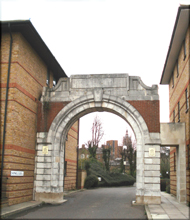
The only surviving part of the Hospital - the archway
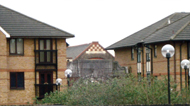
The archway can just be seen (in centre of image) from across the Close

Looking into Chopwell Close from West Ham Lane
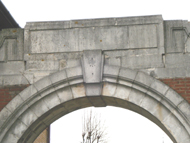
The inscription on the archway can just be discerned - "Queen Mary's Hospital for the East End"
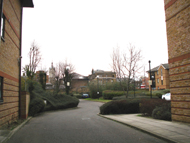
Beyond the archway, looking into Chopwell Close

New housing on Bryant Street.
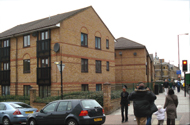
New housing along West Ham Lane
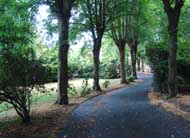
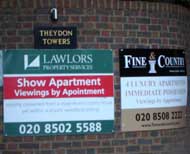
Theydon Towers
in Theydon Bois was once the children's convalescent home for the
Hospital. The mansion was built in the late 19th century from
yellow brick with stone dressings. An imposing building, it is
currently being redeveloped into four apartments and the site is
inaccessible because of the building works.
Parsons J 1962 A Short History of Queen Mary's Hospital for the East End. London, West Ham Group Hospital Management Committee.
www.aim25.org.uk
www.newhamstory.com (1)
www.newhamstory.com (2)
www.newhamstory.com (3)
www.newhamstory.com (4)
Return to home page